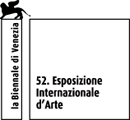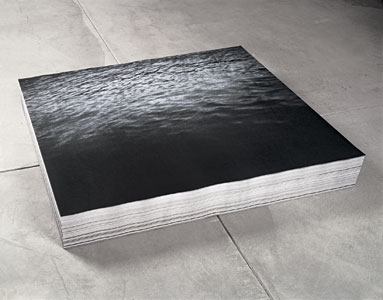 |
||||
|
||||
|
||||
ARTEXT : La Biennale di Venezia
AMERICA
Alcuni anni fa, nel gennaio del 1996, Felix Gonzalez-Torres moriva a New York, dopo una folgorante carriera di artista. Le sue opere più note sono senz'altro le pile e le accumulazioni
di caramelle e stampe, che i visitatori dei musei erano invitati a
prelevare, distruggendo l'opera stessa. Tim Rollins - "Come sono nate le tue accumulazioni di fogli e caramelle? Gonzales-Torres - È difficile dirlo. Non me lo ricordo, davvero. Le prime pile le ho fatte con i pezzi delle date. Intorno al 1989 tutti lottavano per avere un pezzo di parete. Lo spazio sul pavimento invece era libero, era una zona marginale. E poi volevo restituire allo spettatore e al pubblico qualcosa che non era mai stato veramente mio: un’esplosione di informazione, che in realtà è un’implosione di significato. In secondo luogo quando ho iniziato a fare i mucchi di fogli - è stato per la mostra da Andrea Rosen - volevo fare una mostra che sparisse completamente. Era un lavoro sulla sparizione e l’apprendimento. Volevo anche attaccare il sistema dell’arte e volevo essere generoso. Volevo che il pubblico potesse conservare il mio lavoro. Era davvero eccitante che qualcuno potesse venire alla mostra e potesse andarsene con un mio lavoro. (trax.it/tim_rollins.htm)
- Felix Gonzales-Torres: America brings together key examples of the artist's work in and around the U.S. Pavillon to create a coherent installation focused on Gonzales-Torres's optimistic but critical relationship to his adoptive culture. Though all' "untitled " the parenthetical subtitles of his individual works function like whispered cues providing subtle guides to interpretation that only imply and never prescribe. Gonzales-Torres's largest and final lightbulb string (comprising twelve
illuminated strands), "Untitle" (America),1994, graces the
entrance hall of the pavilon and extends into its public courtyard.
In one of the rooms flanking the rotunda appear two paper stacks: "Untitled" (Republican
Years), 1992, with its funereal border and "Untitled", 1991,
a photograph of an ocean surface cast in the blackest of light. In
the gallery of the rooms flanking the rotunda appear two of idealized
(male) roles inscribed in tribute Theodore Roosevelt on the exterior
façade of the America Museum of Natural History in New York:
autor, statesman, scholar, humanitarian, historian, patriot, ranchmann,
conservationist, explorer, naturalist, scientist, and soldier. These
images surround two paper stacks from 1989 that bear the inscriptions "Memorial
Day Weekend" and "Veterans Day Sale", respectively-wry
commentaries on how national(istic) holidays in the United States are
commercialized and rendered utterly banal. In the gallery to far left of the entrance rests "Untitled" (Pubblic Opinion), 1991, a large carpet of black licorice candies that intimates the complexities of pubblic consensus even as it offers itself to gallery visitors, endlessly distributing itself into the world at large. This work is accompanied by a selection of Gonzalez-Torres's early photostats-blank, captioned screens that cite political and social events in eccentric inventories of our collective consciousness. In the gallery to the far right of the entrance, an indoor billboard of a lone bird soaring through an open sky covers the long wall as a portal to imaginary states. Its only illumination is the single string of light bulbs, "Untitled" (Leaves of Grass), 1993, which, in this context, references Walt Whitman's ode to the individual spirit and its essential place in American democracy. Because Gonzalez-Torres conceived of his art as "viral" in
nature, existing both within the museum and dispersed throughout the
community by means of its take-away components, the exhibition also
includes a series of twelve outdoor billboards of the same image of
a bird in flight, installed throughout the city of Venice. Presented
without identifying text, these billboard images exist as lyrical spaces
for contemplation amid the bustle of urban life. The exhibition also features "Untitle", 1992-95, a never-before-realized sculpture in the courtyard of the pavilion: two adjoining, circular reflecting pools, the sides of which touch just enough at a single point to share an almost undetectable flow of water. Between 1992 and 1995 Gonzales-Torres sketched at least five variations of these pools, expanding upon his motif of paired rings. The first known sketch for the twin pool represents Gonzalez-Torres's submission to an outdoor sculpture competition sponsored by Western Washington University in Bellingham, Washington in 1992. The drawing indicates that each pool should be twelve-feet in diameter, a detail that would remain constant in each subsequent drawing and description. Gonzalez-Torres returned to the motif in 1994 when planning a one-person exhibition for the capc Musée d'Art Contemporain in Bordeaux, witch he postponed because of its proximity in time to his Guggenheim retrospective. Tragically, he died before the show could be realized. For the Bordeaux installation. he envisioned a pair of indoor pools flush with the floor. When outlining his ideas for the exibition, Gonzalez-Torres also created a sketch of an outdoor version of the pools, and this is the one realized on the occasion of the Venice Biennale. Untitled and open-ended in terms of their possible materials, the pools presented here were carved from white Carrara marble - [press]
|
||||
Artext © 2007 |
